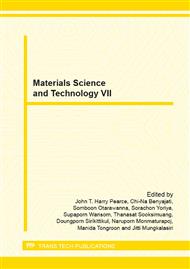p.153
p.158
p.163
p.173
p.177
p.182
p.188
p.193
p.197
The Effect of Ultrasonic Vibration on Properties of Weld Metal
Abstract:
Weld metal mechanical properties and weldability of materials are closely related to the microstructure of the weld metal. A significant amount of research has been studied to improve microstructure of weldments such as weld pool stirring by using magnetic arc oscillation and arc pulsation. In this work, the effect of ultrasonic vibration was used to modify weld metal solidification to improve microstructure of the weld metal. Microstructure and mechanical properties of carbon steel weld metal (ER70S-G filler metal) were studied. Filler metal was melted by using Gas Tungsten Arc Welding (GTAW) in a water-cooled copper mold. Ultrasonic vibration with a frequency of 20 kHz was applied during solidification of the weld metal. Microstructure and mechanical properties of weld metal were compared with those of conventional weld metal (no ultrasonic vibration assistance). Scanning Electron Microscopy (SEM) was also used to determine microstructure and phases at high magnification. The results showed that ultrasonic vibration applied during solidification promoted grain refinement in the weld metal. Mechanical properties of weld metal were improved significantly, microstructure analysis correlated well with the mechanical test results.
Info:
Periodical:
Pages:
177-181
Citation:
Online since:
March 2013
Authors:
Price:
Сopyright:
© 2013 Trans Tech Publications Ltd. All Rights Reserved
Share:
Citation:


